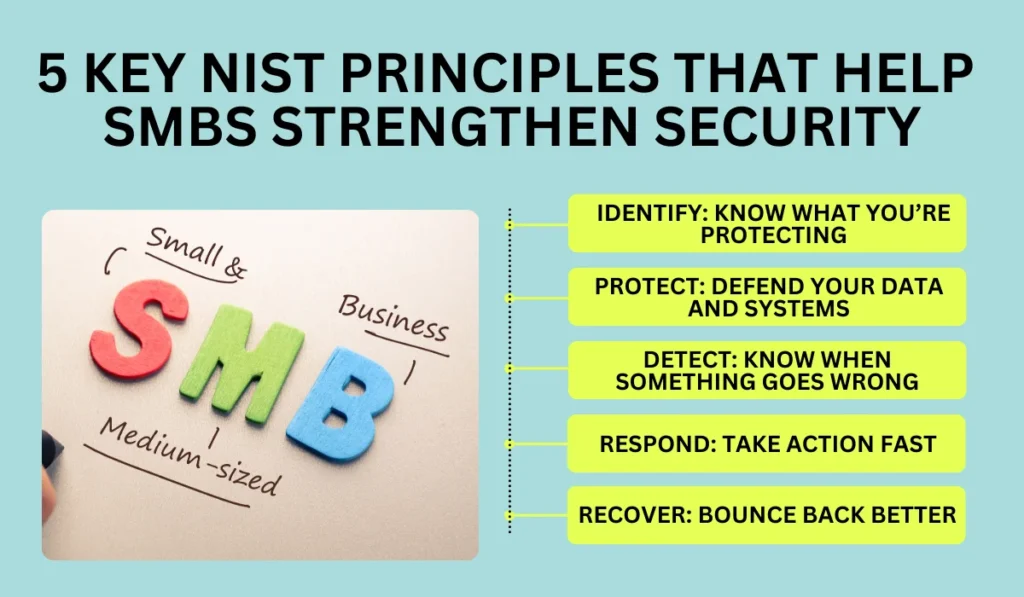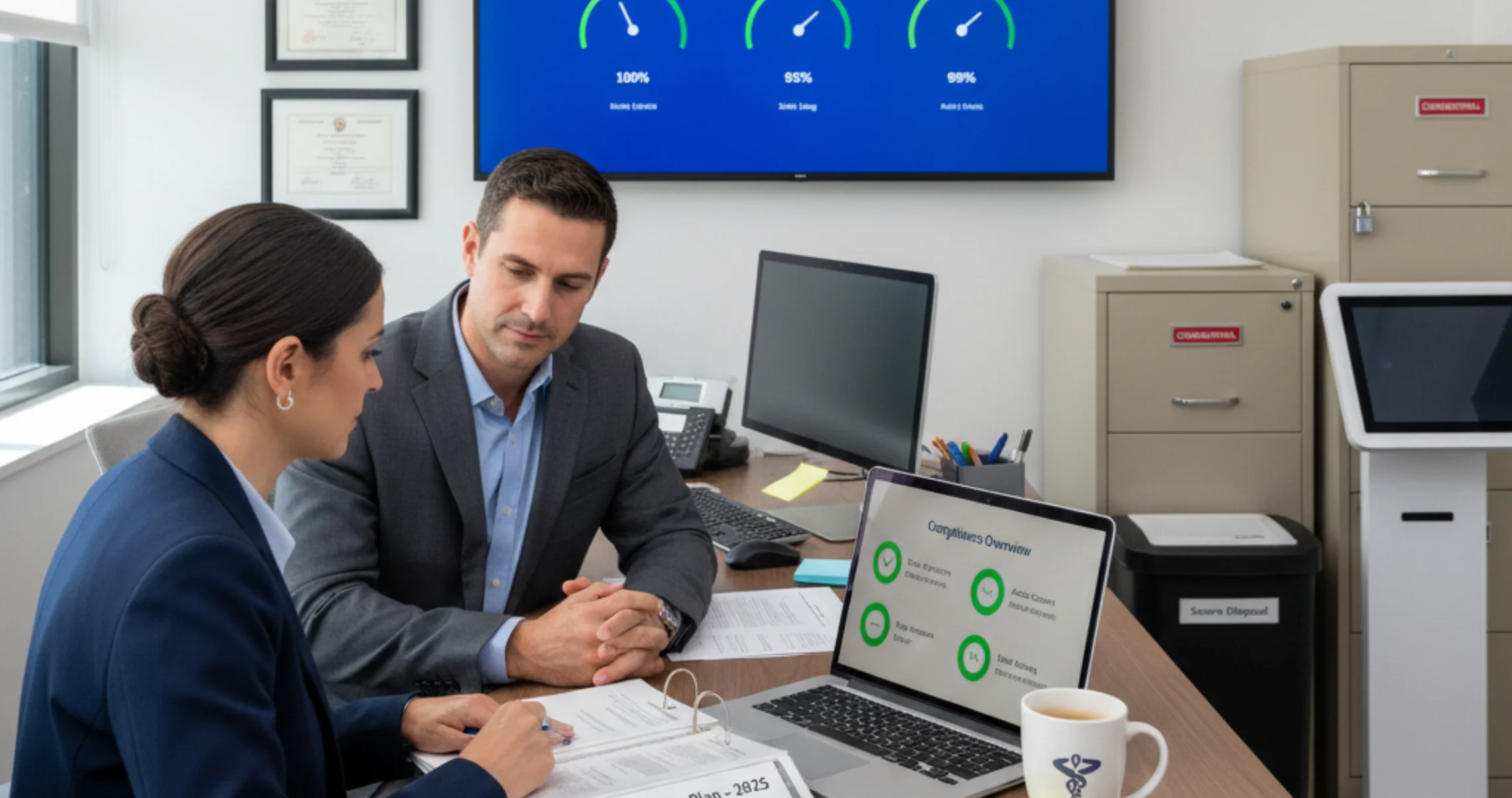Patrick Sullivan

If you’re part of a small or medium-sized business (SMB), you already know how much is on the line. Your operations rely on a web of vendors, platforms, and customer data, yet many SMBs still lack formal cybersecurity measures.
That’s risky. Only 9% of business owners say they were victims of a cyberattack. Yet, 50% report harmful cyber activity, and 64% lack a dedicated person or technology partner to detect or stop threats.
You may not be working directly with federal agencies, but if you handle sensitive information, work within a regulated supply chain, or plan to bid on government contracts, the compliance requirements you face are getting stricter.
If you’ve been hearing more about the NIST framework lately, there’s a good reason. Cybersecurity threats are becoming more advanced, and you need to be prepared. That’s where the National Institute of Standards and Technology (NIST) steps in. As a part of the U.S. Department of Commerce, NIST develops the special publications that shape cybersecurity standards used across industries and by federal agencies.
This is where NIST compliance comes in. Built around the widely respected NIST Cybersecurity Framework and its foundational special publications, it offers a simple, scalable approach to improve data security, reduce risk, and meet compliance, without overwhelming your team.
In this guide, you’ll discover how NIST compliance works, what it means for SMBs like yours, and why working with Parachute is the most cost-effective, practical way to implement cybersecurity practices that drive trust, resilience, and growth.
Key takeaways
- NIST compliance builds trust with enterprise clients and government agencies by demonstrating that your business prioritizes cybersecurity.
- Strong protections like MFA, access controls, and response plans not only reduce risk but can also improve your insurance standing and help win contracts.
- Waiting for a breach is too late; early action saves time, money, and reputation.
- Partnering with experts ensures your policies lead to real-world protection that grows with your business.
Why NIST Compliance Matters for SMBs
NIST’s most well-known tool is the Cybersecurity Framework (NIST CSF). Originally designed to protect government systems and contractors, this framework has become a go-to model for managing cybersecurity risk in the private sector. High-trust industries like finance, healthcare, legal, and SaaS companies rely on it to guide their data security strategies.
But it’s not just for the big players. An increasing number of small businesses are adopting the NIST CSF because it offers a practical, phased roadmap to strengthen their cybersecurity practices without needing a massive IT team. The framework helps you:
- Identify where you’re vulnerable
- Protect the systems and data that matter most
- Detect cyber incidents before they escalate
- Respond quickly to limit damage
- Recover operations and learn from what happened
In short, the NIST framework is a robust foundation for cybersecurity risk management. It turns uncertainty into action and sets your business up for long-term resilience.
What does NIST compliance mean for SMBs?
It’s essential to understand that NIST compliance isn’t a legal mandate for most SMBs. Instead, it’s become a widely recognized industry best practice that helps your business stay competitive, secure, and credible. Think of it as a strategic investment, not a regulatory burden.
When your cybersecurity posture aligns with the NIST framework and its special publications (like NIST SP 800-171), you unlock advantages that go far beyond risk reduction:
- Stronger security decisions: NIST helps you align your cybersecurity measures with your actual business risks.
- Trust from partners and vendors: As more companies scrutinize their supply chain, being NIST-compliant demonstrates that you’re a secure, reliable partner.
- Access to new opportunities: Many federal government contracts and private-sector RFPs now include NIST-based compliance requirements.
- Insurance benefits: Demonstrating good-faith cybersecurity practices can reduce premiums or improve claim outcomes.
- Future-proofing: Building your foundation on the NIST framework makes it easier to prepare for audits like HIPAA or SOC 2.
If your business handles Controlled Unclassified Information (CUI) or touches federal workflows, compliance with NIST SP 800-171 is essential.
But even if you don’t fall into a regulated category today, the benefits of adopting NIST’s cybersecurity practices now can prepare you for where your business is going next.
The challenge: why most SMBs struggle with NIST compliance
Once you understand the value of the NIST framework, the next challenge is implementation. For many small businesses, this is where good intentions run into practical roadblocks.
Even if you’re committed to improving cybersecurity, there are common reasons why SMBs fall short:
- Limited resources: Small teams juggle many responsibilities. Cybersecurity often takes a back seat.
- Lack of expertise: Most SMBs don’t employ full-time cybersecurity professionals.
- Reactive mindset: Many SMBs focus on compliance only after facing a phishing attack, audit issue, or breach.
- Ongoing demands: The NIST framework isn’t a one-and-done checklist. It requires continuous attention: policy updates, monitoring, and staff training.
Unfortunately, attackers know this. 46% of SMBs globally have experienced at least one cyberattack, and the consequences can be severe; 18% filed for bankruptcy, and 17% were forced to close following an incident.
When your business handles sensitive data, relies on vendor integrations, or operates in regulated sectors, these gaps put you at risk. Cyber threats are evolving, and staying ahead requires more than good intentions; it requires structure.
5 key NIST principles that help SMBs strengthen security

You’ve seen why NIST compliance matters; now here’s how it works. The NIST Cybersecurity Framework (NIST CSF) uses five core functions to guide your cybersecurity efforts in a structured, sustainable way.
These principles provide clarity for your team, align with the expectations in NIST 800-171, and help strengthen your overall security posture without overwhelming your resources.
1. Identify: know what you’re protecting
Your first step in strengthening your security posture is understanding what systems, data, and assets you’re working with.
- Asset inventory: Document all your hardware, software, cloud environments, and networked devices.
- Data classification: Identify which data is sensitive or qualifies as Controlled Unclassified Information (CUI).
- Risk mapping: Run a formal risk assessment to evaluate potential vulnerabilities and business impact.
This process aligns directly with NIST 800-171 and provides a baseline for all future cybersecurity efforts.
2. Protect: defend your data and systems
After identifying what needs protection, your next move is to put defenses in place. These actions help reduce your attack surface and meet core NIST compliance requirements.
- Establish access controls that limit system entry to only those who need it.
- Require multi-factor authentication (MFA) for all business-critical platforms.
- Apply encryption to both data at rest and data in motion.
- Deliver regular security awareness training so your team knows how to recognize threats.
This function not only strengthens your security posture but also supports sustainable cybersecurity risk management practices.
3. Detect: know when something goes wrong
No system is impenetrable, which makes early detection a vital part of your security strategy.
- Implement log monitoring across your infrastructure.
- Use anomaly detection to flag unusual activity.
- Set up real-time alerts to notify you the moment an issue arises.
They provide your team with better visibility and enable faster action before a breach causes significant damage, which are essential elements in the NIST CSF.
4. Respond: take action fast
Speed and clarity in your response can mean the difference between a minor disruption and a major crisis.
- Develop an incident response plan that defines roles, communications, and recovery workflows.
- Conduct simulations or tabletop exercises to test your plan.
- Keep thorough records to meet any compliance requirements.
Having a response framework in place demonstrates that you’re not only meeting NIST 800-171 expectations but also prioritizing your company’s long-term security posture.
5. Recover: bounce back better
Once you contain an incident, recovery gives you the chance to return to normal and come back even stronger.
- Maintain off-site, versioned backups and regularly test recovery procedures.
- Build a business continuity plan that ensures mission-critical operations don’t stall.
- Conduct post-incident reviews to uncover weaknesses and make data-driven improvements.
Recovery is not just about restoration; it’s about resilience, one of the core values embedded in the NIST framework. 51% of SMBs say that staying ahead of constantly evolving cyber threats is their biggest cybersecurity challenge.
By adopting these five functions, you’re not just securing your business; you’re actively strengthening your security posture, fulfilling the spirit of NIST 800-171, and preparing for whatever comes next.
Why work with a managed IT provider for NIST compliance
The good news? You don’t have to tackle this alone.
Partnering with a Managed IT Service Provider (MSP) like Parachute gives you access to experienced cybersecurity professionals who make the NIST framework practical and achievable, no matter the size of your team.
Here’s how an MSP supports your NIST compliance journey:
- Risk assessments: Identify vulnerabilities across your infrastructure before attackers do.
- Policy development: Define how your team manages access, sensitive data, and device usage.
- Security control implementation: Deploy core cybersecurity defenses such as MFA, encryption, and endpoint protection.
- Staff training: Build employee awareness to help stop phishing and reduce human error.
- Audit preparation: Ensure documentation is ready for HIPAA, SOC 2, or federal government compliance requirements.
- Remediation plans: Parachute creates a roadmap to fix security gaps based on urgency and business impact.
Instead of stitching together tools or playing defense, an MSP helps you build a proactive cybersecurity program that evolves with your business; one that turns compliance into a long-term advantage.
How Parachute helps SMBs navigate compliance with confidence
At Parachute, we specialize in assisting SMBs to confidently adopt and maintain NIST compliance with scalable, strategic, and tailored solutions.
Here’s how we make compliance achievable and sustainable for growing businesses:
- Essentials NIST CSF Assessments to evaluate your current security posture and identify risks
- Security roadmaps that align compliance milestones with business priorities
- Access and device policies designed for hybrid, remote, and on-site teams
- Live staff training sessions to prevent phishing and promote a culture of security
- Documentation support to help you meet requirements for audits, insurance, and contracts
- Scalable frameworks that grow with you from NIST to SOC 2, HIPAA, and CMMC
Whether you’re handling sensitive data, working with regulated industries, or building vendor trust, Parachute helps you move beyond minimum requirements. You get real-world support, not generic solutions, so that you can build cybersecurity maturity with clarity and confidence.
Schedule your Essentials NIST CSF Assessment today and take the first smart step toward stronger security.
FAQs
What is NIST compliance for small businesses?
NIST compliance means following cybersecurity standards from the National Institute of Standards and Technology. For small businesses, it provides a clear framework to protect sensitive data, reduce risk, and meet growing vendor and contract requirements.
Is NIST compliance required for SMBs?
No, NIST compliance isn’t legally required for most SMBs. But if your business handles federal data, works in a regulated industry, or wants to win government contracts, it’s often mandatory, or highly recommended.
What does the NIST Cybersecurity Framework include?
The NIST Cybersecurity Framework includes five key areas: Identify, Protect, Detect, Respond, and Recover. These help small businesses in building a strong, structured cybersecurity program without needing a large internal team.
How can a managed IT provider help with NIST compliance?
A managed IT provider helps SMBs meet NIST compliance by running risk assessments, setting up protections, training staff, and preparing for audits. They turn complex requirements into practical steps your business can manage.


